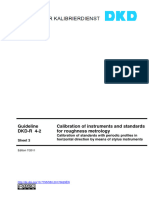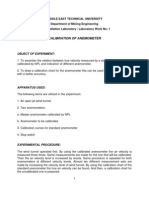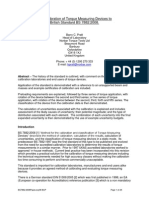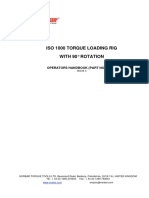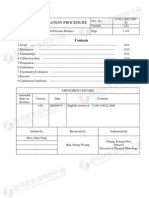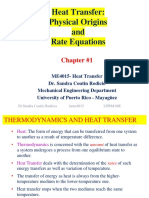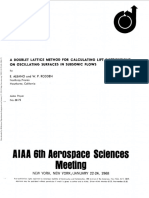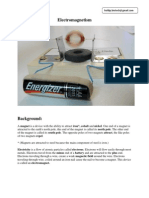Calibration of Metal Tapes
Calibration of Metal Tapes
Uploaded by
arabcalCopyright:
Available Formats
Calibration of Metal Tapes
Calibration of Metal Tapes
Uploaded by
arabcalOriginal Description:
Copyright
Available Formats
Share this document
Did you find this document useful?
Is this content inappropriate?
Copyright:
Available Formats
Calibration of Metal Tapes
Calibration of Metal Tapes
Uploaded by
arabcalCopyright:
Available Formats
SOP No.
11
Recommended Standard Operations Procedure for
Calibration of Metal Tapes
Bench Method
1. Introduction
1..1. Puose of Calibration
Metal tapes are used by contractors, surveyors, and others for
building layouts, measurement of land areas, establishment of land
boundaries, and similar purposes. Inaccuracies in such measurements
can cause structural misalignents, boundary controversies, and other
problems. The test method described here provides a procedure to
calibrate such tapes to four decimal places in the case of measure-
ments in inches, and to 6 decimal places for measurements expressed
in units of meters. The calibrated length bench is used as the
standard.
1.2. Prerequisites
1.2.1. Verify that the calibrations for the length bench scale and
the thermometers are available and valid at the time of
measurement.
1.2.2. Verify that the ocular microscope used in measuring
differences in lengths is in good working order.
1.2.3. Verify that the technician has been trained in the use of
this method. Note that the precision and accuracy attainable
depend upon the care exercised in aligning the tape on the
length bench, and the skill acquired in the use of an optical
micrometer to measure scale differences.
2. Methodology
2.1. Sumry
The tape to be calibrated is laid over the bench scale and sufficient
tension is applied to insure that it lies flat on the bench.
Differences between the graduation on the tape and that of the bench
scale are measured using an ocular micrometer. The temperature of
the tape is observed and corrections applied to the reference
temperature of 20 .C, as required, using formlas or tables which are
provided. All data are recorded, using the forms contained in
Appendix A. Tyical lengths to be tested on a 100-foot tape when
using the 16-foot length bench are: every foot through 10 feet and
then 15, 20, 30, 40, 45, 50, 60, 70, 75, 80, 90, and 100 foot
lengths.
SOP 11-1
2.2. Apparatus
2.2.1. Two thermometers, capable of indicating temperatures in the
range of 15 to 30 .C, and accurate to f 0.5 .C.
2.2.2. A l6-foot, (5-meter) bench with attached calibrated length
scale.
2 . 2 . 3 . Optical microscope wi th ocular scale having dimens ions spaced
at 0.002 inch intervals.
2.2.4. Clamps and weights to apply an appropriate tension to the
tape under calibration. (See "Tension Specifications", in
Appendix C. 3 .
2 . 3 . Procedure
2.3.1. Clean the tape by first wiping with a soft cloth, and then
with a soft cloth saturated with alcohol to remove protective
oil film. (See Appendix C, Section C. 1. )
2.3.2. Lay two thermometers (see 2.2.1) on the bench at intervals of
1/3 and 2/3 of the length of the bench to determine its
temperature at the time of the test.
2.3.3. Place the clamp at the zero end of the bench so that the zero
mark on the tape is near the zero graduation on the length
bench. Note: Yhen the ring is part of the measuring tape, a
special clamp-holder must be used. See Appendix C.5 for
further information on this matter.
2.3.4. Lay the tape flat on the bench. The tape should extend well
beyond the end roller of the bench to permit tension to be
applied. Slide one end of a fabric strap onto another tape
clam. Fasten this tape clam to the tape on the portion
that extends below the end roller. Hang the tension weight
from the bottom of the fabric strap. Check to see that the
tape is lying straight on the bench and parallel to the bench
scale. Adjust, if necessary. Apply tension using a weight of
10 pounds, unless other tension is desired. (See Appendix
C. 3.)
2.3.5. Adjust the tape clamp on the zero end of the bench so that
the tape zero graduation coincides with the center of the
zero graduation of the bench. Note: Some tapes are cali-
brated using the one foot mark as the reference point, rather
than the zero graduation. In this case, align the I-foot mark
of the tape with the zero graduation mark of the bench and
interpret all following instructions accordingly.
2.3.6. Check all alignents and coincidence of zero graduations
before proceeding with calibration. Use the lateral
adjustments at the left end of the bench to facilitate
alignent. Caution! Take care that ta'De is not touched or
SOP 11-2
disturbed durin2 the following seouence of measurements.
Record all observations on a suitable data sheet such as the
one included in the Appendix.
2.3.7. Record the temperatures indicated by the two thermometers.
2.3.8. Place the ocular microscope on the bench in the vicinity of
the zero position and align it so that its scale is parallel
to the tape under test. (See GMP No. 2 for instructions on
how to make readings.)
2.3.8.1. Observe readings of left and right sides of zero
graduation of tape and record to the nearest .001
inch.
2.3.8.2. Observe readings of left and right sides of zero
graduation of bench and record to the nearest .001
inch.
2.3.9. Move ocular microscope successively to each graduation that
needs to be calibrated and record readings similarly as in
2.3.8.1 and 2.3.8.2.
2.3.10. Retu ocular microscope to the zero graduation and repeat
readings to verify that the tape has not moved. Accept all
previous data if present zero reading does not disagree with
previous reading by more than 0.001 inch; otherwise, discard
all previous data and repeat entire sequence of readings
until a satisfactory set is obtained.
2.3.11. Remove the tension weights, move the tape, hang the tension
weights back on the fabric strap, and realign the zero marks
on the tape and the bench to coincidence.
2.3.12. Make a second set of measurements as directed in 2.3.8,
2 . 3 . 9, and 2. 3 .10.
2.3.13. Record the temperatues indicated by the two thermometers.
2.3.14. After all measurements are completed, apply a thin film of
oil to the tape.
2.4. Calculations
2.4.1. Calculate 1m and Sm for each series of measurements and for
each scale interval, as follows:
1m -
(right edge reading of tape + left edge reading of tape)
2
Sm -
(right edge reading of bench + left edge reading of bench)
2
SOP 11-3
Record at appropriate places on the data/worksheet.
2.4.2. Calculate d - xm - Sm for each scale interval, and record on
the data/worksheet.
..
2.4.3. Obtain the correction to the standard, Cs ' from the
calibration certificate for the length bench scale and
tabule.t:e. Note: If the 1 - foot mark or other mark is used as
the reference mark, the correction must be made, taking this
into account.
2.4.4. Calculate the temperatue correction, K, from the equation
K - Ln ((T-20) (as - Ax) J
where
as - coefficient of linear expansion for the standard
bench (10.63 x 10-6/oC)
Ax - coefficient of linear expansion for the tape
(11.60 x 10-6/oC)
Ln - nominal length of tape interval under test
In this equation, T is the average of the four temperature
readings described in Sections 2.3.7 and 2.3.11. In the case
of steel tapes, the value for K may be obtained from the
table in Appendix B.
2.4.5. Calculate a correction, Cx, for each trial and each scale
interval.
Cx - d + Cs + K
2.4.6. Calculate and report the mean, C;, of the two corrections for
each interval.
2.4.7. Compute the absolute difference between the two corrections
for each interval and record as R on the worksheet.
2.4.8. Comute the length of the tape under the 10 lb. load as
Lo-L+Cx
3. Determination of AE Value
3.1. Replace the tension weight (10 pound) used in 2.3.4 with a 20 pound
weight (or with one 10 pounds heavier than that used in the orginal
calibration) .
3.2. Adjust the coincidence of the zero graduation as was done in 2.3.5.
3.3. Adjust the tape so that it lies flat and parallel to the bench scale.
3.4. Chek the zero graduation coincidence and readjust if necessary.
SOP 11-4
3.5. Record zero readings as instructed in 2.8.
3.6. Record readings at the longest scale interval of the bench measured
under the original tension, as instructed in 2.3.9.
3.7. Take a second series of measurements as described in 3.5 and 3.6.
3.8. Repeat appropriate calculations and compute the len~th of the tape
under 20 lb. load as
Li-L+Cx
3.9. Compute the AE value using the equation
Qi - QO
AE- Ln
Li - La
where
AE - cross sectional area times Young's modulus of elasticity
QO - the lower load applied to the tape (e.g., 10 lb.)
Qi - the higher load applied to the tape (e.g., 20 lb.)
La - the length of the tape under load Qo (mean of two
measurements)
Li - length of the tape under load Qi (mean of two mesurements)
Ln - nominal length of the interval under test
4. Determination of Weight-per-Unit Length
4.1. Weigh the tape and reel (or case) to :t 0.1 g. (Wl)
4.2. Remove the tape from the reel or case and weigh the empty reel or
case to :t 0.1 g. (Wc)
4.3. Measure the length of any blank ends on the tape to :t 0.01 foot. (LB)
4.4. Use the nominal value 2.5 g for the weight of the loop normlly used
on steel tapes. (WL) If a larger or smaller loop is used, its weight
should be estimated or the weight of the loop should be obtained from
the tape manufactuer.
4.5. Compute the weight-per-unit length using the equation
Wi - Wc - WL
Weight/length -
~ + LB
where
Wl - weight of tape plus reel (or case)
We - weight of reel (or case)
WL - weight of loop (2.5 g)
. ~ - graduated length of tape
LB - length of blank ends
SOP 11-5
5. Assignents of Uncertainty
'\
5.1. The unertainty, Uc' of a correction (the mean of two measurements)
is given by the expression
Uc - f
ts
Us +-
J2
Where Us is the uncertainty assigned for the correction for the
standard and s represents the estimate of the standard deviation of a
single measurement. The value for t (corresponding to a probability
level of 99.73') and the number of degrees. of freedom on which sis
based will be found in Table 9.3.
5.1.1. If control charts a~ not maintained, s may be estimated from
the average range, R, of the ranges, R (absolute differences
of the measured corrections) over all n intervals. Thus,
_ m
R--
n
an s is estimted by
s - i:di
The factor di is obtained by interpolation of the values in
Table 9.1. The degrees of freedom, ii, associated with s
should be takn as one-half the degrees of freedom shown
below the appropriate di factor in the same table. *
5.1.2. If control charts are Ilintained and the measurement system
is in a state of statistical control, the value of s on which
the control limits are based may be substituted in the
eqution of 5.1 and the corresponding value for II is used
when selecting the value of t to be used.
5.1.2.1. If control charts are maintained, the second trial
-y be eliminated with a somewhat larger random
unertainty of the measurement. An R control chart
(difference of duplicates) is recommended and only
the zero and one other scale interval (randomly
selected) are measured in duplicate. The differ-
ence in the Cx values (R) obtained in these control
measurements is plotted on the control chart and
indication of measurement process control permits
*Degrees of freedom are reduced approximtely by the factor one-half because
the same zero interval measurement, are used for each interval estimted.
Values should be rounded to the nearest whole numer.
SOP 11-6
the assignent of the process standard deviation to
all measurements made at that time in calibrating
the rule. The uncertainty, Uc' becomes
Uc - :t (Us + ts)
Note: See Chapter 7.4 for further information on
the maintenace and use of R control charts.
SOP 11-7
APPENDIX A
CALIBRATION OF METAL TAPES - BENCH METHOD
.'
TEST ITEM
TAPE MFGR
SUBMITTED BY
DATE
TEMPERTU: START:
TEM 1
TEMP 2
FINISH: TEMP 3
TEM 4
AVERGE TEMP
TENSION SUPPORT
OBSERVER SHEET NO.
COEFFICIEN OF l:ANSION OF UNOWN, 8x-
COEFFICIEN OF EXANSION OF STANAR, as _
Cx - d + Cs + K ; K - Ln ((T - 20) (as - 8x))
NOTE: Coefficient of expansion for steel tape - 11.60 x 10-6/.C
Coefficient of expansion for length bench - 10.63 x 10-6/.C
T
Inter-
r
X
S
Corr' n
val
i
to K** Corr'r'.
;nge
d*
,
Xi a Left Right Mean Left Right Mean
Stand. Temp.
to X of
si 1 Edge Edge
Xm
Edge Edge Xs
Xm - sm
Cs Corr' n
Cx Cx
X
1
S
2
Avera e, ~
X
1
S
2
I:
Avera e, c.
1
2
Avera e,
~v
I:
1
I
2
Average,
e"
*Carry average difference to at least four decimal places if average is in
inches, CArry to at least six decimal places if average is in meters.
**Carry to at least four decimal places if in inches; at least six decimal
place. if in meter..
SOP 11-8
APPENIX A
CABRATION OF KE TAPES - BENCH KEOD
TEST ITE Surveyor' 8 TaDe 100 ft
TAPE KF
lif1in
SUBKTrED BY
ABC Comnanv
DATE 8/29/86
TEERTU: STAl: TE.1 22.3 .C 1' 2 22.4 .C
FISH: TEK 3 22.4 .C 1' 4 22.5 .C AVEGE TEK 22.4 .C
TESION 10- 1b load
SUPO throuthout
OBSERVE
HO
SHE NO. 1
-6
. ~EFCIEN OF .EXANSION OF 1J,
Ax -
11.60 x 10 I.C
-6
COEFCIEN OF EXANSIOR OF ST,
a. - 10.63 x 10
I.C
Ox - d + C. + IC ; IC - i. (('1 - 20)(.. - Ax))
ROT: Cofflclent of exploi for .tee1 tape - 11.60 x 10-61.c
Coefflclent of e~".loi for i.iith be - 10.63 x 10-61.c
.
'1
Inter-
l'
X
S
Corr'n
val
1
co It~ Corr'n
1l- xi & Left Ript Hea Left Ript Hem d'* Sta., '1ap . co X of
.1
" 1 Iele
Ede
Sa Ece Up
; Sa-..
c. Corr'n
Ox Ox
:
X 0-10'
1 .204
.218 .211 .215 .221 .218 - .007 +.002 ~28
-.aJ
S 0-10'
2 ".0025.
.182
.197 .1895 .196 .202 .199 -.0095
+.002 .428 -.00778
Avera .. c.
- .0065
IX 0-15' 1 .166
.182 .174 .184 .190 .187 - .013 +.003
':2 -.010
.0001
S 0-15' 2 .198
.214 .206 .218 .224 .221 -.015 +.003 :'2 - .01?A
Avera _, c.
- .01142
'XU-2O' 1 .liO .174 .167 .168 .174 .171 -.00
- .001 :-0014 - .00514
s 0-5' 2 .144 .159 .1515.15 .160 .157 -.0055 .
.0015.
- .001 ..14 - .0066
Fr. 0-20' .C: - -.OU42 + (-.00589) - -.0173
Avera _, Co
- .oos
/XU-30' 1 .216 .232 .22. .219 .225.22 .00
+.003 7002 . 00.
.0001 S 0-15' 2 .140 .156 .148 .145 .151 .148
.00 +.003 702
. 00
FrOl 0-30' Ox - - .01142 + .00 3S - -.00 78
Averaie, Ox
.oo
*C avera,_ diff_reDC CO at 1e..t fou deci- place. if &vraie is 11l
1D., ca CO at 1e..t .1x dec1l1 p1ac.. if averaie is in ..ter..
** CO at l..t fou cSc1l place. lf in iDCe.; at l..t .1x cSc1a1
place. lf in _ter..
SOP 11-'
'''0
APDlIX 1-1
TEKER CORUIOR FAC FO CAIRT.9l OF ST TAPlS
(AL VAL 1R IRaI X 10 )
Teel'aeue. . .C
Ln
22 23 24 25 2' 27 28 29
30
Feet
19 20 21
1.
0.1 0 -0.1 -0.2 -0.3 -0.5 -0.6 -0.7 -0.8
-0.9 -1.0
.1.2 2
0.2 0 -0.2 -0.5 -0.7 -0.9 -1.2 -1.4 -1~' -1.9 -2.1
-2.3 3
0.3 0 ~.3. -0.7 -1.0 -1.4 -1.7 -2.1 -2.4 -2.'
-3.1 -3.5 i.
0.5 0 -0.5 -0.9 -1.4 -1.9 -2.3 -2.8 -3.3 -3.7 .-4.2
-4.7 5
.C., ., 0 -0.' -1.2 -1.7 -2.3 -2.9 -3.5 -4.1 -4.7
-5.2
.5.8 6
0.7 0 -0.7 -1.4 -2.1 -2.8 -3.5 -4.2 -4.9
-5.6 -6.3 .7.0 7
0.8 0 -0.8 -1.6 -2.4 -3.3 -4.1 -4.'
-5.7 -6.5
-7.3 -8.1 8
0.9
0 -0.9
-1.9 -2.8 -3.7 -4.7
-5.6 -6.5 -7.4 -1.4
-9.3 9
1.0 0 -1.0 -2.1 -3.1 -4.2 -5.2 -6.3
-7.3 -1.4 -9.4
-10.5
10
. 1.2 0 -1.2 -2.3 -3..5 -4.7 -5.' -7.0 -1.1
-'.3 -10.5
-11.6
15
"1.7 0 -1.7 -3.5
-5.2 -7.0 -1.7 -10.5
-12.2 -14.0
-15.7 -17.5
20
2.3 0 -2.3 -4.7
-7.0 -9.3 -U.6 -14.0
-1'.3 -U.6 -21.0 -23.3
30
3.5
0 -3.5 -7.0 -10.5 -14.0 -17.5 -21.0 -24.4
-27.9 -31.4 -34.9
40
4.7
0 -4.7
-9.3 -14.0 -II.' -23.3 -27.' -32.6 -37.2 -41.9
-4.6
45
5..2
0 -5.2 ~10.5
-15.7 -21.0 -26.2 -31.4
-H.7 -41. ,
-47.1 -52.4.
50
5.8
0 -5.1
-U.6 -17.5
-23.3 -29.1 -34.'
-40: 7 -4.6 -52.4
-51.2
60
7.0
0
-'.0 -14.0 : -21.0
-27. , -34. , -41.'
-48.'
-55.' -'I.' -".. 70
1.100
0
-'.1 -1'.3 -24.4
-32.6 -4.7
..., -57.0
-65.2 -73.3 -11.5
75
'.7 0 -1.7
-17.5 -26.2
-34.' -4.' -52.4
-'1.1 -".1 -71.6 -87.3
10
9.3
0
-'.3 -18.6. -21.0
-37.2 -4.6
-55.'
-65.2 -74.5
-n.i -93.1
90
10.5
0 -10.5
-21.0 -31.4 -41.9 -52.4 -62.'
-73.3
-n.i .94.3 -104.'
100
11.6
0 -U.6
-23.3 -34.' -4.' -51.2 -". .
-11.5
-93.1 -104.8 -116.4
For uule:
.'
Po~ ~ - 20 fet at 25 .C. t: l:~a~e comati_
18 -0,.OOU6 l-s. ,
SO 11-10
APrERIX 1-2
VAI FO "
ftEl CDOl FO CAt..WCl or ST TA
GI IR KE -6
(AL VAW IN KE X 10. , )
'Iearacw. .
.C
Li
it
24 25 26 27 2' 29 3
Ilters 20 21 22 23
0.1 0.1 0 -0.1 -0.2 -0.3 -0.4 -0.5 -0.6 -0.7 -0.' -O.t -1.0
0.2 ct.i, 0 -0.2 -0.4 -0.6 -0.' -1.0 -1.2 -1.4 -1.6 ,-1.7 -1.9
0.3 0.3 0 -0.3 -0.6 -0.9 -1.2 -1.5 -1.7 -2.0 -2.3 -2.6 -2.9
0.4 0.4 0 , -0.4 -0.' -1.2 -1.6 -1.9 -2.3 -2.7 -3.1 -3.5 -3.9
0.5 0.5 0 -0.5 -1.0 -1.5 -1.9 -2.4 -2.9 -3.4 -3.9 -4.4 -4.9
0.6 0.6 0 -0.6 -1.2 -1.7 -2.3 -2.9 -3.5 ".1 ".7 -5.2 -5.8
0.7 0.7 0 -0.7 -1.4 -2.0 -2.7 -3.4 ".1 .... -5.4 -6.1 -6.8
0.' 0.' 0 -0.1 -1.6 -2.3 -3.1 -3.9 ".7 -5.4 -6.2 -7.0 -7.8
0.9 0.9 0 -0.9 . -1.7 -2.6 -3.5 -4.4 -5.2 -6.1 -7.0 -7.9 -'.7
1.0 1.0 0 -1.0 -1.9 -2.9 -3.9 .... -5.' -6.' -7.' -'.7 -9.7
2.0 1.9 0 -1.9 -3.9 -5.' -7.' -9.7 -11.6 -U.6 -15.5 -17.4 -19.4
3.0 2.9 0 -2.9 -5.' -'.7 -11.6 -14:6 -17.5 -20.4 -23.3 -26.2 -29.1
4.0 3.9 0 -3.9 ' -7.' -11.6 -15.5 -19 .4. -23.'3 -27.2 -31.0 -34.9 -38.' .
5 4.' 0 .... -9.7 -14.6 -19.4 -24.2 -U.L -34.0 -38.' -4.6 -4'.5
10 9.7 0 -'.7 -It .4 -2'.1 -38.' ...5 -,..2 -67.' -n.6. -'7.3 -17.0
15 14.6 0 .14.6 -2'.1 -4.6 -,..2 -72.1 -'7.3 -101.' "116.4 -UL.0 -145.5
20 19.4 0 -It .4 -38.1 -51.2 -n.6 -17.0 -U6.4 -U5.' -155.2 -174.6 -194.0
25 24.2 0 -24.2 -41.5 -72.' -17.0 -UL.2 -145.5 -169.' -194.0 -211.2 -242.5
30 29.1 0 -29.1 -51.2 -17.3 -116.4 -145.5 -174.6 -203.7 -23.' -261.9 -291.0
For ..i.: Foe i. - 4 _cent ae 25 .C ti c.racu coi:d.
1s -0.~~194 _cen.
sor U-U
,'Mc
APPENIX C
Supplemental Informtion
C .1. Cleanng
To clean a steel tape before caibration, first wipe the tape with a soft
cloth. Then v1th a soft cloth satuatii~ with alcohol to rem the film
of oil used to protect the tape.
After calibration, a th fii. of liht oil, suc as sewing IIchine oil,
should be applied to th tape for protection.
c. 2 . Tolerances
The tolerances for measuring tapes are those stated in the Federal
SpeCification, -Tapes, Heasuing (General Use)- whch i. Federal Spec.
GG-T-106D dated Novemer 12, 1969. Steel tape. of leng 25, SO, 75,
and 100 feet fall unr Tye II c1... S. The toleranes are .tated in
section 3.8.2.6 and given below for reference.
3.8.2.6. Accuracy. The inacuracy in th leD of th ribbon, when
supported on a horizonta suac with a tension of 10 Pouds
at a temeratue of 68 .F or 20 .C shal DOt exceed 0.050 inc
for the 7S-foot leng, an 0.100 1n for the ioo-foot leu.
Tolerances for a 30-meter tae are given bele
Lellirth Interval
Toleranoe
o thou 15 -ter.
lS th 22 _tars
22 thou 30 -ters
C.3. Tension Specification
The leiith of a ta rill be affected by ':'. tratue of the ta, the
tension applied to th ta, &D th 1I;~r in vbch the ta is aur-
ted. The tape rill stretc when tension is applied an will retu to
its nomal length whn the tension i. remd, pr09c:d th ta ba not
been pemantly c:fomed vb it v.. .tretced. The teion at which
. steel ta &ie to be caibrated, exre..ed in tena of the loa in
poun (or k1lograu) to be applied to obta th tension, are as
follows:
1.27 _ (0.050 1D)
1.91 _ (0.075 1n)
2.54 _ (0.100 1D)
leii l..s th 25 feet (10 .) 3 1/2 lb (2 q)
1eiith of 25 ft thoug 100 ft (10 . - 30 .) 10 lb (5 q)
length greater th 100 feet (30 .) 20 1b -(10 q)
'1 loacl shoud be accurate vU:hin 0.1 1b (45 g).
SOP 11-12
C.4. Methods of Support and Tension Considerations
Tapes calibrated in a State laboratory are normally supported on a
horizontal surface throughout the entire length of the tape. Also, tapes
may be calibrated and used when supported in catenary types of suspen-
sion. In these cases, the tape is supported at equidistant points
because the weight of the tape affects its length. The weight of the
tape increases the tension and the "sag" causes the horizontal length to
be shorter than when the tape is supported throughout its length.
Equations are given in GMP No. 10 to compute the horizont~l straight- line
distance of a tape supported at N number of equidistant catenary suspen-
sions and for computing the tension of accuracy, defined as the tension
that must be applied to the tape interval to produce its designated
nominal length at the observed temperature of the tape.
It is sufficient to provide the user of a steel tape with the calibrated
length of the tape under standard temperature and tension conditions, the
weight per unit-length of the tape, and the AE value for the tape. This
information will enable the user to compute the values desired using the
equations cited above.
C" 5 " Zero Reference Point
Metal measuring tapes submitted to a State laboratory for calibration
normally will be made of steel. ~~nerally, these tapes will have a ring
on the end of the tape. For maximum calibration and measurement accur-
acy, a tape should have a blank end between the ring and the zero
graduation. The zero graduation is then more precisely defined and more
easily referenced for calibration and use.
Tapes that have the ring as part of the measuring portion of the tape are
more difficult to calibrate than a tape with a blank end. When the ring
is part of the measuring portion of the tape, the zero reference point
shall be the outside end of the ring unless otherwise specified. It is
more difficult to obtain a good zero reference setting on the ring due to
its curvature and to parallax in reading the edge of the ring against a
reference mark. Additionally, the ring may become permnently deformed
in use and change the length of the tape. For these tapes the NBS
normally calibrates from the I-foot mark over the length of the tape and
then calibrates from the ring to the l-foot mark. These values are
reported separately so the user can obtain maximu measurement accuracy
by using the l-foot gradua~ion as the zero reference point.
Yhen the ring is part of the measuring range of the tape, a special
holder for the ring is needed to clam the tape to the length bench. A
strap with an open area in the middle is needed to permit the end of the
ring to be seen. The strap is slipped through the ring and the strap is
clamped to the length bench. An examle is illustrated below.
-----
~
I Ii
-----
2
1::C:~
3
SOP 11-13
The edge of the tape to be calibrated (the reading edge) is the edge
nearest the observer when the zero graduation is to the observer's left.
Yhen viewed through a microscope, some graduations will appear to have
irregular edges. The portion of the graduation to be used for calibra-
tion is the portion of the graduation at the bottom of the reading edge
of the tape. This provides a reference point that can be repeated and
referenced by others. Do not attempt to estimate the Wbest overall" edge
of a graduation because this is not easily repeatable and cannot be
accurately reproduced by others. If the graduations to be calibrated do
not reach to the edge of the tape, the tape should not be calibrated.
C. 6. Temperature Considerations
The reference temperature for length calibrations is 20 .C. The length
of the tape can be determined at any other temperature T by using the
equation:
where
~ - Lio (1 + aCT - 20))
~ - length of the tape at a temperatue T
Lio - length of the tape at 20 .C
a - linear coefficient of expanion
Since a is always positive, it can be seen that for temeratues above
20 .C, the tape is longer th it is at 20 .C. For temperatures below 20
.C, the tape is shorter th it is at 20 .C.
If two length standards have different coefficients of expanion because
they are made of different materials, the lengths of the tapes will
change at different rates as the twperatue changes. If two tapes are
being compared at a temperature other thn 20 .C, these lengths mut be
corrected back to 20 .C for calibration.
If two length standards are being compared and they IU.' .~ the same
coefficient of expansion, 'then as the temeratue change" ::he length
, will change by the same amount. Hence, if the stadards are compared at
a temperatue other than 20 .C, the relationship between the two stan-
dards will be the same as if they were being compared at 20 .C; thus, no
temperature correction is needed.
steel tape
length tape
invar tape
11.60 x 10-6/.C
10.63 x 10-6/.C
4.0 x 10-7/.C
(6.45 x 10-6/.F)
(5.91 x 10-6/.F)
(2.2 x 10-7/.F)
C. 7 . Invar Tapes
Invar is an alloy of nickel and steel. Invar tapes are use:d to obtain
measurements of greater accuracy than can be ..de with steel tapes,
because invar has a very low coefficient of expanion. It has the addd
benefit of being very slow to tarnish from exposure to the atmosphere.
However, invar tapes require very careful hadling to prevent twists and
kink .
SOP 11-14
The load to be applied to an invar tape to maintain the desired tension
is normally 20 lb. A load of 40 lb is used for the higher tension to
determine the AE value (described below). For metric tapes, the normal
load is 5 kg. A load of 10 kg is used to determine the AE value.
C.S. AE Value
The AE value (area elongation value) for a tape is determined by first
calibrating the tape under its norml tension. The load is then
increased by 10 or 20 lb and one length interval is: reca1ibrated to
determine the length of the tape under the increased tension. The AE
fac tor is then computed as:
Q1-QO
AE- Ln
Li - 1. .
where AE - cross-sectional area times Young's modulus of elasticity
QO - the lower load applied to the tape (e.g., 10 lb)
Qi - the higher load applied to the tape (e. g., 20 lb)
La - length of the tape under load QO
Li - length of the tape under load Q1
Ln - nominal length of the interval under test
For examle, suppose a 100 foot tape is calibrated from 0 to 100 feet
with a load of 10 lb applied to the tape. Suppose this length was 99.992
feet. Suppose the load was increased to 20 1b and the new length was
found to be 100.004 feet. The AE value is:
(20 lb - 10 1b) 100 feet 1000 lb feet
AE - - - 83333 lb
(100.004 - 99.992) feet 0.012 feet
It is recommended that the AE value be determined over the longest
interval that is convenient to measure. This minimizes the error in the
AE value because of the better readability of the chage in length.
C.9. Weight per Unit Length
The weight per unit length of a tape can be determined as follows:
1. Weigh the tape and reel (or case).
2. Remove the tape from the reel or case and weigh the empty reel (or
case) .
3. Measure the length of any blank ends on the tape and add this to
the measuring length of the tape.
4. Correct for the weight of the loop on the tape. The weight of the
loop that is normlly. used on steel tapes is approximtely 2.5 gram.
SOP 11-15
The weight per unit length is then computed as:
weight per
uni t length -
weight of weight of weight
loaded reei empty reel of loop
length of tape + length of blank ends
SOP 11-16
You might also like
- Calibration of Pressure GaugeDocument4 pagesCalibration of Pressure Gaugeyash ajay kashidNo ratings yet
- Calibration Laboratory Depth Gauge: Revision Record SheetDocument6 pagesCalibration Laboratory Depth Gauge: Revision Record SheetManivasagan VasuNo ratings yet
- Length Calibration For Pin Gauge and Feeler Gauge. - SarmientoDocument38 pagesLength Calibration For Pin Gauge and Feeler Gauge. - SarmientoEricson Ramos100% (1)
- DKD R 6 2 t5 eDocument9 pagesDKD R 6 2 t5 eSebas BuitragoNo ratings yet
- Power System Analysis - Lecture Notes, Study Material and Important Questions, AnswersDocument5 pagesPower System Analysis - Lecture Notes, Study Material and Important Questions, AnswersM.V. TV100% (1)
- EURAMET CG 18 02 Non Automatic Weighing InstrumentsDocument83 pagesEURAMET CG 18 02 Non Automatic Weighing Instrumentsirismaemoring100% (1)
- (BS 6365 - 2008) - Specification For Precision Vernier Depth Gauges.Document16 pages(BS 6365 - 2008) - Specification For Precision Vernier Depth Gauges.boborg8792No ratings yet
- Humidity and Dew-Point Calibration: Instruments, Systems & ServicesDocument70 pagesHumidity and Dew-Point Calibration: Instruments, Systems & ServicesCyriaque KagororaNo ratings yet
- Depth Micrometer: Calibration Procedure #7 EnvironmentDocument1 pageDepth Micrometer: Calibration Procedure #7 EnvironmentAugusto GansserNo ratings yet
- Calibration and Verification OF Spherical Tanks: Antwerp Februari 2001Document6 pagesCalibration and Verification OF Spherical Tanks: Antwerp Februari 2001m1c2rNo ratings yet
- CP No.401-IPRT CalibrationDocument20 pagesCP No.401-IPRT Calibrationsirsa11No ratings yet
- DKD-R 4-2 Sheet 3 enDocument18 pagesDKD-R 4-2 Sheet 3 enHARIOM INSTRU-LABSNo ratings yet
- Calibration NDTDocument11 pagesCalibration NDTAnbalagan RenuNo ratings yet
- Instrument Calibration ProcedureDocument16 pagesInstrument Calibration ProcedureMohammad Nurayzat JohariNo ratings yet
- OIML R120-E10Document37 pagesOIML R120-E10Roxana apazaNo ratings yet
- Calibration of AnemometerDocument4 pagesCalibration of AnemometerAhmet ŞenNo ratings yet
- Calibration and ISO 9000Document2 pagesCalibration and ISO 9000iresendizNo ratings yet
- BS7882 2008 Uncertainty Paper 2Document9 pagesBS7882 2008 Uncertainty Paper 2Student ForeignNo ratings yet
- SOP No. 12 Recommended Standard Operating Procedure For Calibration of Metal Tapes Tape-to-Tape MethodDocument12 pagesSOP No. 12 Recommended Standard Operating Procedure For Calibration of Metal Tapes Tape-to-Tape MethodZoran IlkovNo ratings yet
- CP No.601-Hydraulic Type (Pressure) - RevDocument18 pagesCP No.601-Hydraulic Type (Pressure) - Revamelchan_tiqueNo ratings yet
- F71-F90 Dial IndicatorApplication PDFDocument20 pagesF71-F90 Dial IndicatorApplication PDFKiranNo ratings yet
- EA-4-02 REV01 - Expression of The Uncertainty of Measurement in CalibrationDocument29 pagesEA-4-02 REV01 - Expression of The Uncertainty of Measurement in CalibrationTiago Guimarães100% (1)
- Norbar HandTorque KitsDocument2 pagesNorbar HandTorque KitsnoormanmubarakNo ratings yet
- 009-Measuring Tape - Steel RuleDocument4 pages009-Measuring Tape - Steel RuleAjlan Khan100% (1)
- BS 7882 - 2008 PaperDocument25 pagesBS 7882 - 2008 PaperMohamed Naser0% (1)
- EURAMET Cg-12 V 2.0 Guidelines On EvaluationDocument24 pagesEURAMET Cg-12 V 2.0 Guidelines On EvaluationRichard FloresNo ratings yet
- Iso 1000 Torque Loading Rig With 90° RotationDocument8 pagesIso 1000 Torque Loading Rig With 90° Rotationjon1224No ratings yet
- DKD Guidance - Calibration of Liquid WaterDocument14 pagesDKD Guidance - Calibration of Liquid WatergustavoesanchezNo ratings yet
- Gauge Block Wring Error Using Ethyl Alcohol As MediumDocument10 pagesGauge Block Wring Error Using Ethyl Alcohol As MediumRommel CoronaNo ratings yet
- Norma ISO 13385Document24 pagesNorma ISO 13385jorge_t_71100% (3)
- GTM - Torque Primary Standard MachineDocument12 pagesGTM - Torque Primary Standard MachinergénezNo ratings yet
- Vernier CalliperDocument5 pagesVernier CalliperWahyu FirmansyahNo ratings yet
- 022-Temperature CalibratorDocument4 pages022-Temperature CalibratorAjlan Khan100% (1)
- Thread Plug Gauge BackupDocument7 pagesThread Plug Gauge BackupmarketingrklabsNo ratings yet
- Mettler Pj1220 ManualDocument3 pagesMettler Pj1220 ManualMehrdad AkbarifardNo ratings yet
- Calibration PresentationDocument25 pagesCalibration Presentationchirag patelNo ratings yet
- Pressure Gauge Calibration TG13 Version 2 December 2017Document6 pagesPressure Gauge Calibration TG13 Version 2 December 2017iptNo ratings yet
- Clibration Laboratory Layout PDFDocument16 pagesClibration Laboratory Layout PDFjrlr65No ratings yet
- 06 Torque ToolsDocument22 pages06 Torque ToolsJuanGómezNo ratings yet
- Measure Uncertainity in Torque WrenchDocument11 pagesMeasure Uncertainity in Torque WrenchAnonymous uXdS9Y7100% (2)
- Height Gauge Calibration Procedure: 1.0 Standards and EquipmentDocument2 pagesHeight Gauge Calibration Procedure: 1.0 Standards and EquipmentKiranNo ratings yet
- Threads-Setting Adjustable Ring Gages Per ASME B1.2Document3 pagesThreads-Setting Adjustable Ring Gages Per ASME B1.2Muhammad Nadeem AzamNo ratings yet
- Determination of Color by SpectrocolorimeterDocument11 pagesDetermination of Color by Spectrocolorimeternvithyarajan6872No ratings yet
- Calibration Procedure KrissDocument12 pagesCalibration Procedure KrissALP69No ratings yet
- MG 411Document12 pagesMG 411Trần Khắc ĐộNo ratings yet
- Dimensional Measurements: Group 22 MembersDocument12 pagesDimensional Measurements: Group 22 MemberscfellowNo ratings yet
- MQA Lab ReportDocument15 pagesMQA Lab ReportMuhammad Waleed TariqNo ratings yet
- Metrology and Quality Assurance Lab: Department of Mechanical EngineeringDocument7 pagesMetrology and Quality Assurance Lab: Department of Mechanical EngineeringAliNo ratings yet
- Astm E145 1994 OVENDocument4 pagesAstm E145 1994 OVENNinit MiyuNo ratings yet
- Calibration Report For Digital Thermometer: Sample Customer S/N: X-XXXX Report Number: W195839Document4 pagesCalibration Report For Digital Thermometer: Sample Customer S/N: X-XXXX Report Number: W195839Sherwin John Navarro100% (1)
- Final ReportDocument53 pagesFinal ReportmirelamanteamirelaNo ratings yet
- EURAMET Cg-15 V 2.0 Guidelines Calibration Digital Multi MetersDocument18 pagesEURAMET Cg-15 V 2.0 Guidelines Calibration Digital Multi MeterspopistinaNo ratings yet
- Asme B16.34Document15 pagesAsme B16.34Achraf Ismail100% (1)
- Dead Weight Tester InfoDocument6 pagesDead Weight Tester InfoElias Kapa100% (1)
- EURAMET cg-15 V 2.0 Guidelines Calibration Digital MultimetersDocument18 pagesEURAMET cg-15 V 2.0 Guidelines Calibration Digital Multimetersrobust calNo ratings yet
- SOP No. 12 Recommended Standard Operating Procedure For Calibration of Metal Tapes1 Tape-to-Tape MethodDocument14 pagesSOP No. 12 Recommended Standard Operating Procedure For Calibration of Metal Tapes1 Tape-to-Tape MethodEdinson Mejia VieccoNo ratings yet
- Recommended Standard Operations Procedure ForDocument12 pagesRecommended Standard Operations Procedure Forprasadjoshi781429No ratings yet
- Experiment 1Document7 pagesExperiment 1FaizYoshNo ratings yet
- Tape Calibration Procedure SOP11 - 20141022Document15 pagesTape Calibration Procedure SOP11 - 20141022Bvel2019No ratings yet
- BS 1881 Part 117 83 Spli Tensile StrengthDocument10 pagesBS 1881 Part 117 83 Spli Tensile Strengthrajeshji_000No ratings yet
- Some Basic Microwave ComponentDocument6 pagesSome Basic Microwave ComponentSuper SpecialNo ratings yet
- Xu Et Al - Metal-Insulator Transition in Co-Doped ZnO Magnetotransport Properties - PRB - 73, 205342 (2006)Document5 pagesXu Et Al - Metal-Insulator Transition in Co-Doped ZnO Magnetotransport Properties - PRB - 73, 205342 (2006)sinytellsNo ratings yet
- What Is The Commercial Unit of Electrical Energy Class 12 Physics CBSEDocument1 pageWhat Is The Commercial Unit of Electrical Energy Class 12 Physics CBSEVikas MishraNo ratings yet
- Presentation Heat Transfer - Physical Origins and Rate Equations Chapter 01 Dr. Sandra Coutin Rodicio PDFDocument30 pagesPresentation Heat Transfer - Physical Origins and Rate Equations Chapter 01 Dr. Sandra Coutin Rodicio PDFENo ratings yet
- SFD & BMDDocument113 pagesSFD & BMDMd. Shofiul IslamNo ratings yet
- Doublet Lattice Method PDFDocument13 pagesDoublet Lattice Method PDFAlvaroFernandezVillarNo ratings yet
- Lecture 3.2 RL CIRCUIT JottedDocument20 pagesLecture 3.2 RL CIRCUIT JottedMuhd Darwish Mohd ZailaniNo ratings yet
- PCI Midsem 2021Document1 pagePCI Midsem 2021Omkar AkulwarNo ratings yet
- Bee (Unit-5) (Notes)Document28 pagesBee (Unit-5) (Notes)Jannat ZUBAIRNo ratings yet
- Science 9 Q4 SML17 V2Document15 pagesScience 9 Q4 SML17 V2HotdogNo ratings yet
- DC Machine 32Document4 pagesDC Machine 32Seb TegNo ratings yet
- Ap21 FRQ Physics C Mechanics Set 2Document15 pagesAp21 FRQ Physics C Mechanics Set 2Aleemah ferozeNo ratings yet
- PhysicsDocument116 pagesPhysicsPritam ZalkeNo ratings yet
- KK Free Cooling FCCDocument2 pagesKK Free Cooling FCCWilson Mota SantosNo ratings yet
- PHY1 June 2006Document2 pagesPHY1 June 2006api-3726022No ratings yet
- A Flywheel Is A Rotating Mechanical Device That Is Used To Store Rotational EnergyDocument11 pagesA Flywheel Is A Rotating Mechanical Device That Is Used To Store Rotational EnergyNigussie AdemNo ratings yet
- mODULE # 2. Indl Air Cond'ng .MidtermsDocument18 pagesmODULE # 2. Indl Air Cond'ng .MidtermsEmmanuel MiguelNo ratings yet
- Physics Revision Notes (By @class10 - Icse)Document9 pagesPhysics Revision Notes (By @class10 - Icse)zilkag47No ratings yet
- Res (18ee653)Document10 pagesRes (18ee653)shaheed jafarNo ratings yet
- Muhammad Hassan Mushtaq: Master's in Electrical EngineeringDocument3 pagesMuhammad Hassan Mushtaq: Master's in Electrical EngineeringAmir RazaNo ratings yet
- Ma Gnat IsmDocument7 pagesMa Gnat Ismkuldip.biotechNo ratings yet
- Photovoltaics: LCD Display MPPT 25A/60A!Document3 pagesPhotovoltaics: LCD Display MPPT 25A/60A!Md ShNo ratings yet
- Reflex KlystronDocument101 pagesReflex KlystronSusanWiliamNo ratings yet
- Equilibrium of A Rigid BodyDocument20 pagesEquilibrium of A Rigid BodywaqarNo ratings yet
- Package Related Thermal Resistance of LEDsDocument9 pagesPackage Related Thermal Resistance of LEDssalih dağdurNo ratings yet
- Motor de Arranque - EspecificacionDocument1 pageMotor de Arranque - EspecificacionGuido Asqui FloresNo ratings yet
- Inversor - CSI - Datasheet - Inverter - 250K-T800GL03-E - BRA - V1.2 20210729Document2 pagesInversor - CSI - Datasheet - Inverter - 250K-T800GL03-E - BRA - V1.2 20210729fernandoNo ratings yet
- Moving Man WorksheetDocument4 pagesMoving Man Worksheetapi-328318665No ratings yet











